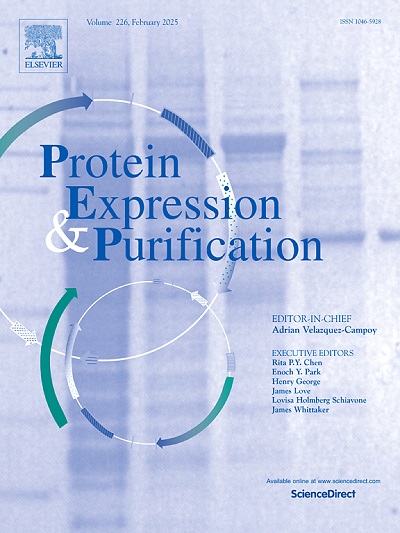控制中子散射中蛋白质氘化的简单规程
IF 1.2
4区 生物学
Q4 BIOCHEMICAL RESEARCH METHODS
引用次数: 0
摘要
蛋白质氘化是利用中子散射/衍射进行生物学研究的一项重要技术。在中子晶体学中,氘化蛋白的使用不仅减少了由于氢原子的背景,而且防止了由于氢原子的负密度而抵消的散射长度密度。在小角度中子散射中,它允许研究蛋白质复合体的单个组分的结构。此外,在准弹性中子散射中,它允许人们测量蛋白质复合物(或蛋白质)中特定组分(或区域)的动力学。蛋白质氘化方案采用在大肠杆菌中培养的表达系统,或者在含有氘化甘油的最小培养基中培养,或者在含有氘化藻水解物(藻蛋白胨)的富培养基中培养。虽然使用最小媒体的协议是主流,但使用富媒体的协议可以轻松控制氘化。在这里,我们优化了制备藻类蛋白胨的工艺,并描述了一种使用藻类蛋白胨进行蛋白质氘化的方案。实验结果表明,实验蛋白α-突触核蛋白(αSyn)的氘化率可达96%。用x射线小角散射测量证实了氘化αSyn和氢化αSyn结构的相似性。此外,氘化程度可以简单地通过在介质中混合氢化和氘化的蛋白胨来控制,并且可以通过向介质中添加氢化氨基酸来对特定氨基酸残基进行氢标记。因此,这里描述的协议作为使用最小介质的补充方法是有用的。本文章由计算机程序翻译,如有差异,请以英文原文为准。
A simple protocol for controlling protein deuteration for neutron scattering
Protein deuteration is a crucial technique in biological studies using neutron scattering/diffraction. In neutron crystallography, the use of deuterated proteins not only reduces the background due to hydrogen atoms but also prevents the cancellation of the scattering length density due to the negative density of hydrogen atoms. In small-angle neutron scattering, it allows the structures of individual components of a protein complex to be studied. Furthermore, in quasielastic neutron scattering, it allows one to measure the dynamics of specific components (or regions) in protein complexes (or a protein). Protocols for protein deuteration employ the expression system in E. coli cultured either in minimal media containing, for example, deuterated glycerol or in rich media containing deuterated algal hydrolysate (algal peptone). While the protocols using the minimal media are the mainstream, the protocols using the rich media allow easy control of deuteration. Here, we optimize the procedure for preparing algal peptone, and describe a protocol for protein deuteration using algal peptone. It is shown that ∼96 % deuteration of the test protein, α-synuclein (αSyn), can be routinely achieved using this protocol. The similarity of the structures of deuterated and hydrogenated αSyn was verified by the small-angle X-ray scattering measurements. Furthermore, the degrees of deuteration can be controlled simply by mixing the hydrogenated and deuterated peptone in the media, and hydrogen labeling of specific amino-acid residues is possible by adding hydrogenated amino acids to the media. The protocol described here is thus useful as a complementary method to those using the minimal media.
求助全文
通过发布文献求助,成功后即可免费获取论文全文。
去求助
来源期刊

Protein expression and purification
生物-生化研究方法
CiteScore
3.70
自引率
6.20%
发文量
120
审稿时长
32 days
期刊介绍:
Protein Expression and Purification is an international journal providing a forum for the dissemination of new information on protein expression, extraction, purification, characterization, and/or applications using conventional biochemical and/or modern molecular biological approaches and methods, which are of broad interest to the field. The journal does not typically publish repetitive examples of protein expression and purification involving standard, well-established, methods. However, exceptions might include studies on important and/or difficult to express and/or purify proteins and/or studies that include extensive protein characterization, which provide new, previously unpublished information.
 求助内容:
求助内容: 应助结果提醒方式:
应助结果提醒方式:


